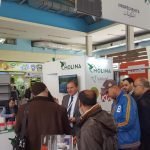Interview – International Supermarket News
Q1-ISN: A Low GWP HFO refrigerant that minimize energy use and environment impact. this is a big news, can you please explain to our readers. – What is it-
A1
An “apples vs. apples”” comparison of new low global warming potential (GWP) hydrofluoro-olefin (HFO) blends versus CO2 and hydrocarbon systems in commercial refrigeration clearly shows how this new technology can give up to 20% reduction in life cycle cost (which includes the all-important electricity bills) with the minimum CAPEX in new retail refrigeration installations.
The ban on high GWP hydrofluorocarbons (HFCs), such as R404A, under the F-Gas regulations is now in force and it brings the choice of what to use for new commercial refrigeration installations under great scrutiny. In conjunction with this, the reduction in F-Gas quota pushes industry to use much lower GWP products than have been used in the past. The question is how to do this without sacrificing the benefits that HFCs have provided for many years?
When we look at the benefits of HFC systems to retailers we see:
- Well known technology which simplifies installation and maintenance while minimising CAPEX costs;
- Robust and dependable operation which reduces retailer downtime and maximises trading hours;
- Safe and energy efficient with the right designs and when maintained correctly.
The big issue is the high GWP of traditional HFCs like R404A that causes an environmental concern when systems leak, which has driven the restrictions in the F-Gas regulations.
The good news is that new technology is now being introduced that seeks to keep the benefits of HFC technology while complying with the F-Gas regulations in the long term.
Opteon™ XL20 (R-454C) has a GWP of only 148 and the refrigerant blend has been developed to ensure that while having a capacity similar to R-404A, its energy performance is better in both medium and low temperature applications. This means that the overall carbon footprint of XL20 equipment is reduced from both a direct (potential leakage) and indirect (energy used to run the system) standpoint. GWP is reduced by some 96% compared to R404A and is only one tenth of the GWP of the current replacement products being used to such as Opteon™ XP40 R449A which is well established in the market with widespread use.
Independent analysis shows this new very low GWP technology when implemented in smaller (300-500m2) up to standard (2000m2) footprint supermarkets has the best 10-year life cycle emissions when compared to other very low GWP solutions such as CO2 and hydrocarbons. This is shown in the figure below.
Figure: Cost vs. Emissions for Various Technologies for a Standard Supermarket (2000m2, 190kW cooling capacity) in UK climate
This is big news as it gives end users and equipment manufacturers more options when looking at moving to low GWP while getting the best energy and cost efficiency.
Q2-ISN: It is still called the next generation refrigerant, is it being used now or it is still in the testing Phase and how long would it take to reach all industries do you think?
A2
Next Generation refrigerants
are so called because they are based on the hydrofluoro-olefin (HFO) technology
which supersedes the older technologies such as HFCs. Very low GWP refrigerants
– in general (i.e. fluorinated or not) – do have constrains in their use issues
which must to be addressed ahead of their implementation in refrigeration systems.
CO2 has high pressures and hydrocarbons are highly flammable. Ammonia is not
used in commercial refrigeration due to its toxicity. HFOs demonstrate a mild
flammability but it has now been demonstrated in several real-life supermarket
installations that this can be easily handled safely with equipment design and
risk assessment. This means that Next Generation very low GWP refrigeration is
now a reality. The rate at which the technology is adopted by the cooling
industry will be determined partly by the availability of equipment. The good
news is that many equipment manufacturers have launched or are close to
releasing the components suitable for the A2L class mildly flammable
refrigerants.
There will be equipment on display at Euroshop that has already been designed
for use with these new refrigerants. Ahmet Yar, who supply major retailer ASDA
with refrigeration cabinets suitable for A2L refrigerants, can be found on
stand C02 in Hall 15 and representatives from Chemours will be present to
answer questions on refrigerants.
More information can be found on our website at opteon.com.
Q3-ISN: How do you see the future of refrigerant?
A3
It is clear no single
refrigerant technology can meet all cooling industry needs but when choosing a refrigerant
solution there should be a focus on how it can be best used to ensure that it offers
both has the minimum transition (i.e. CAPEX) and operational costs as
well as the minimum impact on climate forcing emissions. Most of these applied
costs and emissions come from the fossil fuels consumed to generate the
electricity to power the equipment and therefore technology that produces
cooling most efficiently should be of paramount a priority. As has been
shown, the new blends such as those in the Opteon™ XL range have superior performance
(vs. non-in-kind industrial gases like CO2 or hydocarbons) in this area. Their low
to very low GWP make them a long-term sustainable solution to replace the old
high GWP technologies being forced out by the F-Gas regulation today in Europe
and by the Kigali amendment on a global basis in the longer term after 2030.
Q-4- ISN: Please can you talk to us about chemours history, what other industries you are in?
About The Chemours Company
The Chemours Company (NYSE: CC) is a global leader in titanium technologies, fluoroproducts, and chemical solutions, providing its customers with solutions in a wide range of industries with market-defining products, application expertise and chemistry-based innovations. Chemours ingredients are found in plastics and coatings, refrigeration and air conditioning, mining, and general industrial manufacturing. Our flagship products include prominent brands such as Teflon™, Ti-Pure™, Krytox™, Viton™, Opteon™, Freon™ and Nafion™. Chemours published its first corporate responsibility commitment report in 2018, which highlights goals aligned with the United Nations Sustainable Development Goals. The company has approximately 7,000 employees and 28 manufacturing sites serving approximately 3,700 customers in over 120 countries. Chemours is headquartered in Wilmington, Delaware and is listed on the NYSE under the symbol CC.
For more information, we invite you to visit chemours.com or follow us on Twitter @Chemours or LinkedIn.



